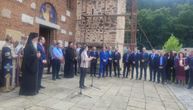Incredible discovery at the foot of Mt. Rudnik: Locals were buried in the ruins of a church
The burials dating back to the time when the church was in use are particularly interesting, according to archaeologists
The previously archeologically unknown medieval fortress Ostrvica had a huge influence on the fate of Mt. Rudnik, but the continuation of archaeological research of a medieval church at the Metaljka site in the village of Zagradje on Rudnik has revealed new, unexpected discoveries.
Not large in size, the Rudnik church was well built and painted, and in some places two layers of frescoes covering the walls can be discerned.
"What is particularly important for us and what we have been investigating for some time are the burials in that church. We have several horizons of those burials at the time when the church was in use, and after the church was demolished, so the local population started burying its dead in its ruins. The burials from the time when the church was in use are particularly interesting, there we have representative headstones of the kind that have not been discovered on Rudnik before, which bear witness to the rich founder's family, buried according to the founder's right. We discovered the founder's tomb, which was opened and probably robbed, around it are interesting tombstones belonging to the Rudnik nobility, such as the tombstone of lord Zarko with his coat of arms and name, who most likely earned the right to be buried in the church due to his social position," Dr. Dejan Radicevic, assistant professor at the Department of Archeology at the Faculty of Philosophy, said.
The discovery of a monumental stone tomb built below the level of the floor of the church was also unexpected. It has a "double slant" ceiling, a small entrance hall and is plastered. Such tombs are characteristic of the early Christian period, so the church may have been built on the site of an older shrine. The excavation is ongoing, and further research may reveal that it dates back to the Late Antiquity and Early Byzantine period.
"Ostrvica played an extremely important role in the defense of the Serbian state at the time, it was the most important fortress in this area, and whoever ruled it ruled the entire region. That's why big battles were fought right there. The people who inhabited that area were miners, they earned their living that way and that is why they were even more interesting to foreign powers to conquer. The fortress was the center of the military administration of the Rudnik area. According to historical data, it first fell under Turkish rule in 1438, and it was used by the Turks for a long time," Radicevic told RINA.
Ostrvica was declared a natural monument in May 2009 and represents a great tourist potential of the Mt. Rudnik region.
(Telegraf.rs)

